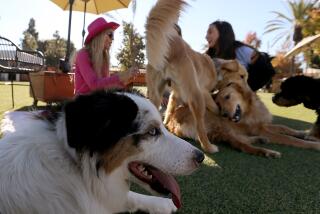Dancing with ol’ twinkle paws
ORLANDO, Fla. — So you say your dog can sniff out bombs, find a lost child in the woods or hunt down an escaped ax murderer.
Yawn.
If you really want to impress, teach your poodle to polka.
Dancing with your dog -- more properly known as canine freestyle -- has become the biggest thing to hit the dog world since the Frisbee. Started in Canada and now spreading around the globe, the dance is a choreographed routine, set to music, between human and hound. Some hope it will eventually be accepted as an Olympic sport.
And why not?
In a few short years, it has grown to boast an international organization, 17 clubs in places from Wisconsin to Australia and an estimated 7,500 human practitioners with at least an equal number of dogs. And that’s not counting the couples who pirouette in the privacy of their own living rooms.
This month, the prestigious Westminster Kennel Club Dog Show will include a canine freestyle demonstration, a sign that even the stodgiest of dog institutions has granted a degree of acceptance.
“All my friends think I’m nuts,” says Marti Gillhouse, a 54-year-old Winter Park, Fla., woman who has danced with her long-tailed Australian shepherd, Dingo, in competition. “But Dingo loves it. He loves to get his tail flying high. He loves to move to the music. He loves to do his little tricks. And he loves it when people cheer.”
We should probably clear up one common misconception: Doggy dancing doesn’t exactly look like what you would normally think of as dancing. Don’t expect the pair to be cheek to whiskers, hand to paw. If you’ve ever seen canine agility competitions -- in which a human handler directs a dog through an intricate obstacle course -- you have an idea of the type of interaction in freestyle.
The dog may spin, step sideways, scoot backward, jump through or over the handler’s arms or weave between the handler’s legs. But there isn’t really a lot of contact between the two, nor does the pooch perch on two legs for very long.
When a New York Times reporter pointed this out to Patie Ventre, founder of the World Canine Freestyle Organization, at a competition in Pennsylvania, Ventre looked puzzled.
“You were expecting Fred and Ginger?” she asked.
In fact, Ventre, a former champion roller skater and ballroom dancer, has spent much of her time since 1999 promoting the sport to a highly divided populace.
“There are those who say, ‘This is the best thing ever. I could watch this all day long. Send me $400 worth of videos,’ ” she says. “And then there’s ‘What a ridiculous idea. What a bunch of stupid people. Don’t they have anything better to do with their time?’ ”
What no one can say, though, is that it’s easy. Anyone who has ever tried to get an untrained dog to “come” or “stay” or “heel” can tell you that. Now imagine holding your pooch’s attention while you go through a two-minute set of difficult maneuvers around a 40-by-80-foot ring, surrounded by strangers who are yelling and clapping.
Oh, and you can’t lure your dog through the routine by holding little treats in front of its nose, either.
“It takes a lot of practice,” says Linda Stites, who leads a group called the Canine Fancy Dancers for the Obedience Club of Daytona, Fla. “There are some who say freestyle is the most difficult of the dog sports. One of the hardest things is picking the right music.”
The Black Eyed Peas might be too fast for your Rottweiler. A Bach concerto might be too slow for your papillon.
Stites, 65, has used a wide variety including “You Are My Sunshine,” “Rock Around the Clock” and “La Bamba.” She once had a three-poodle circus act she took to nursing homes. Thus, dancing with her dogs wasn’t a big leap.
When her group held a performance last May at the city amphitheater in Port Orange, Fla., more than 300 people turned out to watch.
“It’s quite addictive,” says Suzette Wood, 62-year-old president of the Sidekicks, a Central Florida canine freestyle club. Wood has been a dog groomer, trainer and owner of a cat-boarding business. At one time or another, she has dabbled in most of the dog sports.
“I really liked them, but there was always something missing,” she says. “In freestyle, you sort of become your dog’s play toy. You can open up and have fun together. If I so much as talk about it or put on the music, the dogs go wild. It’s like, ‘Come on -- let’s dance!’ ”
It helps, Debbie Turner likes to point out, to pick a piece of music that you really, really like. Because you will be listening to it so much it will implant itself on your brain until nothing shy of a coma will silence it.
Turner, 51, would rather dance with her miniature schnauzer for fun than in competition.
“I did it for a talent contest at a trade show about a month ago,” she says of her lone public performance. “But I needed a couple of glasses of wine first.”
More to Read
Sign up for Essential California
The most important California stories and recommendations in your inbox every morning.
You may occasionally receive promotional content from the Los Angeles Times.










